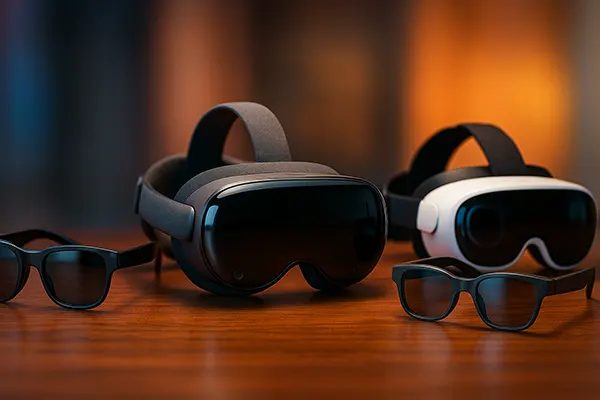
Top 5 AR Glasses Ecosystems for Gamers and Developers: Is the Market Ready for Mass Adoption in 2026?
The development of augmented reality (AR) glasses has made significant progress over the past year, offering immersive interfaces, game engine integrations, and cross-platform ecosystems tailored to developers and gamers. As of June 2025, the most competitive AR ecosystems are already delivering real-world utility and tools for creators, with a focus on user experience, open SDKs, and high compatibility with Unity and Unreal Engine. This article explores the top five ecosystems in the AR market and evaluates whether they are poised for mainstream use by 2026.
Apple Vision Pro (2nd Gen): High-End Precision Meets Developer Tools
Apple’s second-generation Vision Pro, launched in early 2025, continues to lead the premium segment of spatial computing. The device now includes lighter materials, improved battery life, and more natural gesture tracking. Apple has also expanded its software ecosystem with visionOS 2, enabling better rendering of AR scenes in combination with haptics and voice control.
For developers, Apple offers robust support for Unity through RealityKit and ARKit. These frameworks allow for seamless integration of 3D assets, intuitive interface building, and efficient debugging tools. However, the proprietary nature of Apple’s ecosystem means that developers face limitations in cross-platform deployment.
In terms of user experience, the Vision Pro is unmatched in visual clarity and responsiveness. The recent introduction of passthrough APIs and direct Unity runtime support enhances game design flexibility, but the steep price and closed hardware-software model may hinder broader adoption among indie developers and smaller studios.
Key UX and Library Features of Vision Pro
The UX of Vision Pro is anchored in Apple’s core design principles: simplicity, fluidity, and minimal latency. Eye tracking and hand gestures replace physical controllers, allowing immersive AR interaction. With eye-based selection now standard, the learning curve is reduced for new users.
The visionOS SDK includes built-in UI components specifically optimised for AR, such as 3D windows and spatial anchors. It also includes sample Unity scenes and templates that make prototyping faster for game designers.
Although lacking full openness, Apple’s curated developer environment ensures quality control and smooth performance. Combined with support for spatial audio and detailed environmental mapping, the Vision Pro remains a leader in high-fidelity AR gaming and development experiences.
Meta Quest 3+: Affordable Access to Mixed Reality Creativity
Meta Quest 3+, released in March 2025, strikes a balance between affordability and functionality. The headset offers full-colour passthrough, higher resolution than previous versions, and expanded field of view. Meta has focused on encouraging third-party development via its Presence Platform and support for Unity and Unreal Engine out-of-the-box.
Meta’s ecosystem stands out for its openness and commitment to community-driven tools. Developers have access to shared asset libraries, open SDKs, and documentation that simplifies AR app development. The Meta XR Toolkit has also been updated to support hand tracking v2.2 and advanced haptic feedback APIs.
From a gamer’s perspective, Meta Quest 3+ offers impressive value. Multiplayer AR games, hybrid experiences, and app streaming from Android devices position it as a viable AR entertainment hub. However, concerns remain about battery performance and build quality in comparison to more expensive devices.
Developer Environment and Interface Design on Meta Quest
Meta’s support for Unity and Unreal Engine remains strong, with well-maintained packages and tutorials. Developers can deploy builds directly via Meta’s Quest Developer Hub or use side-loading for testing custom apps without approval delays.
The AR interface on Quest 3+ integrates familiar UI elements—such as menus and controls—into spatial environments using the Presence Platform’s Interaction SDK. Voice commands and hand gestures can be integrated using minimal code.
Meta’s collaborative design philosophy is evident in its open GitHub repositories, Discord support channels, and frequent developer webinars. This commitment to openness has made Meta Quest one of the most developer-friendly AR ecosystems available today.

XREAL Air 2 Ultra: Portable AR for Coders and Gamers on the Move
XREAL’s Air 2 Ultra glasses, introduced in May 2025, are lightweight AR glasses designed for everyday use with a strong focus on mobile development. The glasses connect directly to smartphones and laptops, making them ideal for mobile gaming, virtual desktops, and simplified app testing.
While not as powerful as Vision Pro or Quest 3+, XREAL Air 2 Ultra provides key advantages: portability, cost-efficiency, and an open development model. The Nebula OS offers Android-based compatibility and can run AR apps from multiple stores, not just XREAL’s proprietary ecosystem.
The company also released its SDK for Unity, WebXR, and Android developers, encouraging app prototyping on consumer-grade hardware. Support for OpenXR ensures smoother cross-compatibility with emerging AR standards, making it a smart option for entry-level developers.
Interface Simplicity and App Distribution via XREAL
The AR interface on XREAL Air 2 Ultra uses screen mirroring and 3DoF tracking to position virtual content. While lacking full environmental awareness, the system excels in displaying static 3D content and live multiplayer overlays.
The Nebula system allows developers to publish and test apps directly through mobile devices. The dev tools include a debug console, basic UI toolkit, and OpenXR bridge for testing against other headsets.
For gamers, the simplicity of plug-and-play, combined with support for cloud gaming platforms, makes XREAL a low-barrier entry into AR experiences. The limitations of spatial mapping are offset by affordability and flexibility in development use cases.


